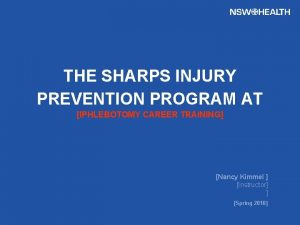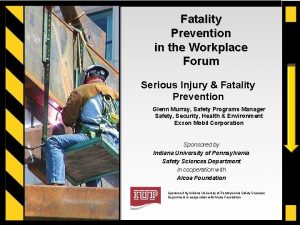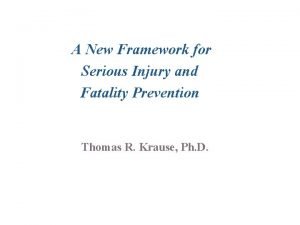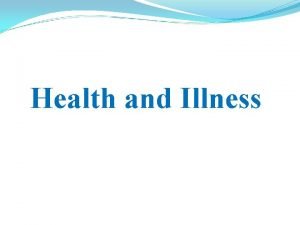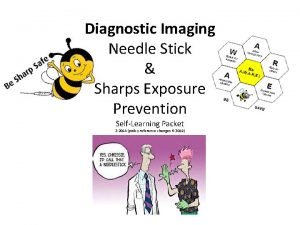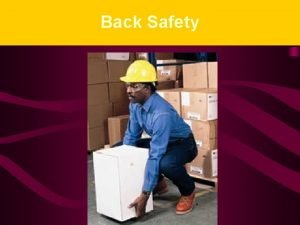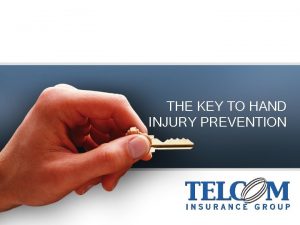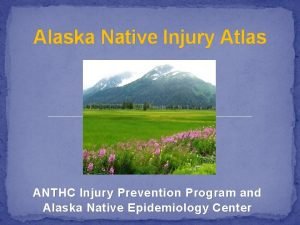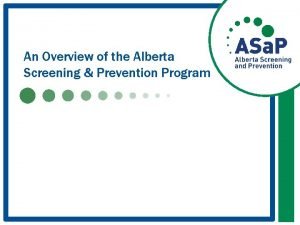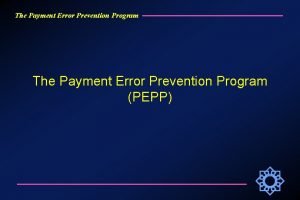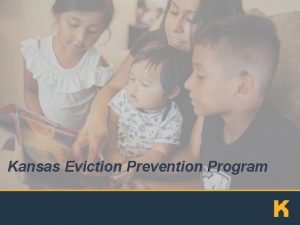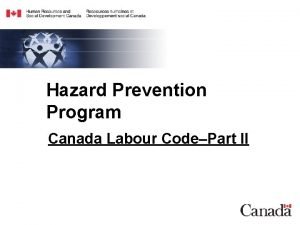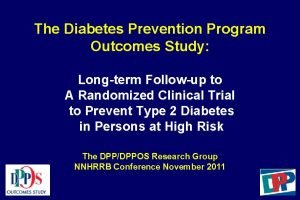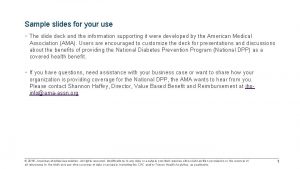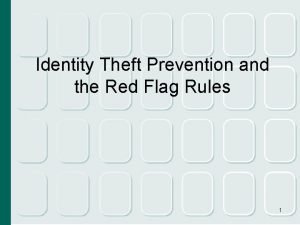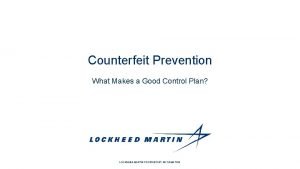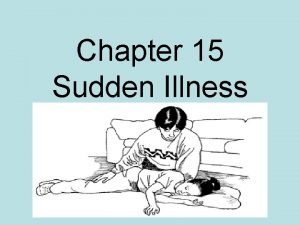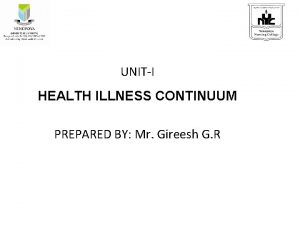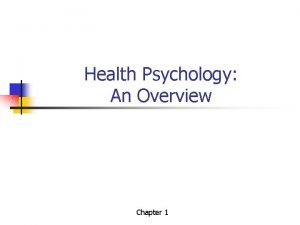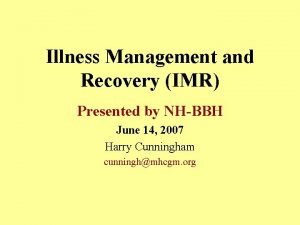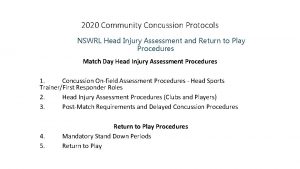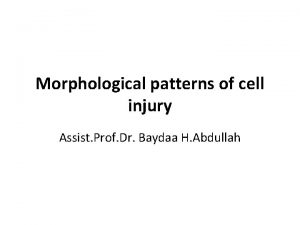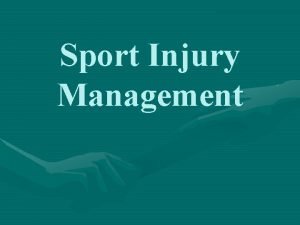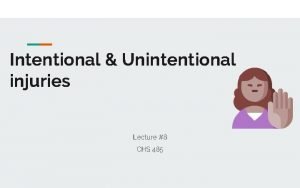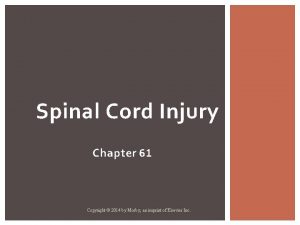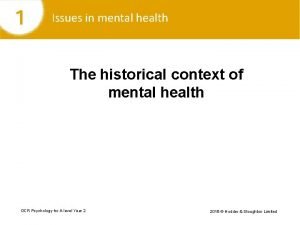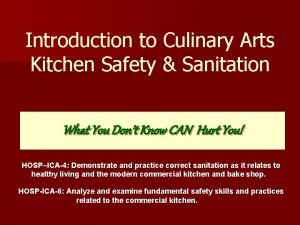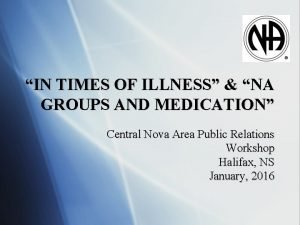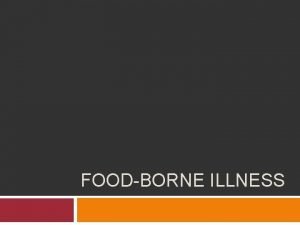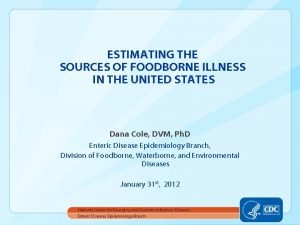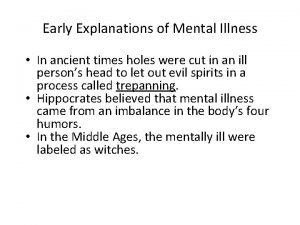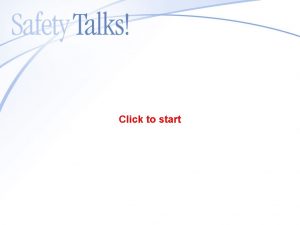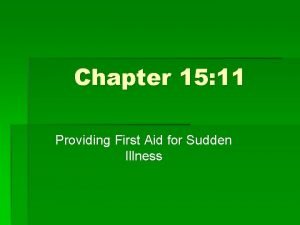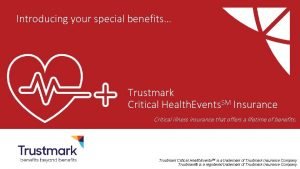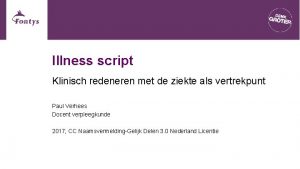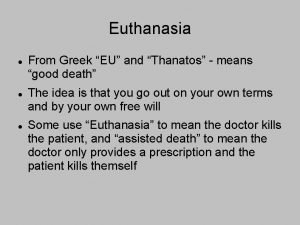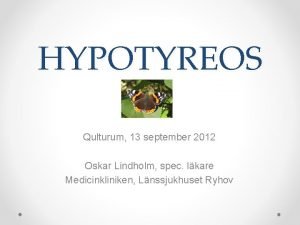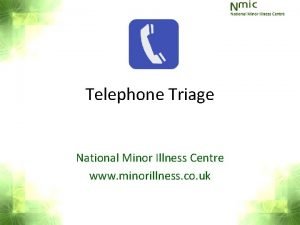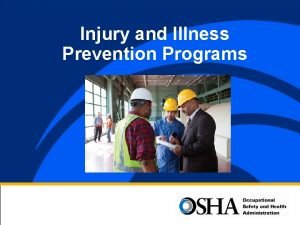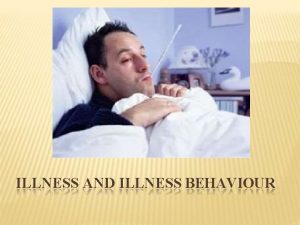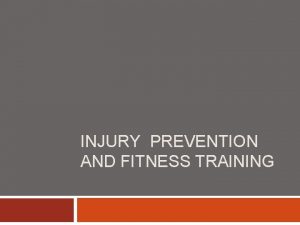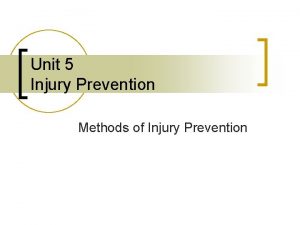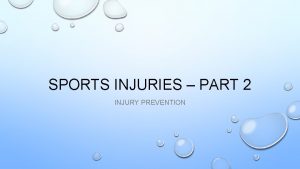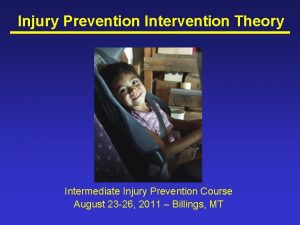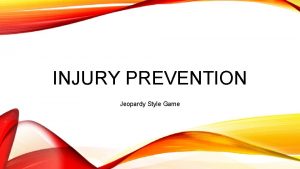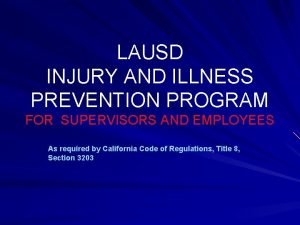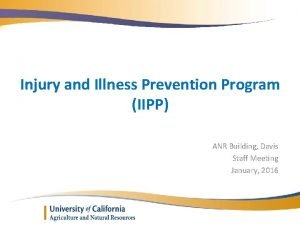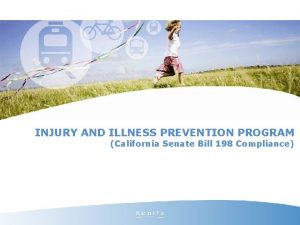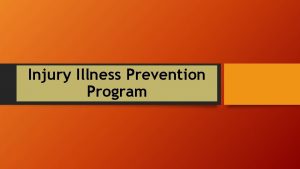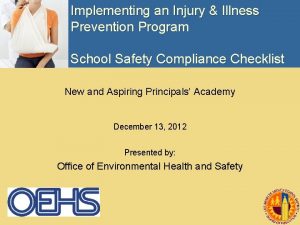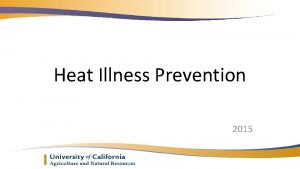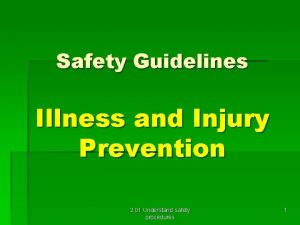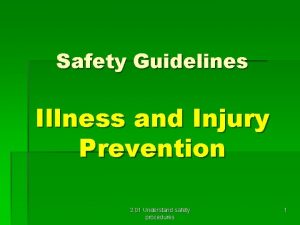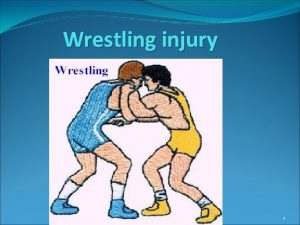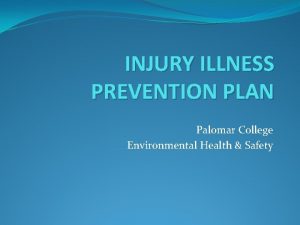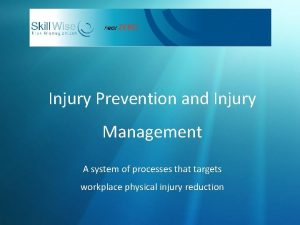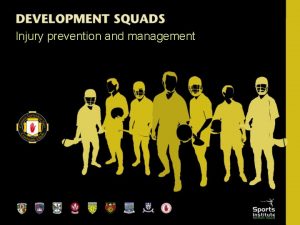What Is An Injury and Illness Prevention Program
























































- Slides: 56

What Is An Injury and Illness Prevention Program (IIPP) California Code of Regulations (CCR) Title 8 General Industry Safety Orders (GISO) Section 3203 requires all employers to establish and implement an effective written IIPP; this presentation list the minimum elements that shall be included in an IIPP Also included in this presentation are some of the commonly used acronyms/initialisms in the occupational safety and health industry

LISMS n n n ACRONYMS/INITIA Occupational Safety & Health Administration (OSHA) Department of Industrial Relations (DIR) Division of Occupational Safety & Health (DOSH) California Occupational Safety & Health Administration (Cal/OSHA) National Institute of Occupational Safety and Health (NIOSH)

ACRONYMS/INITIALISMS n n Injury & Illness Prevention Program (IIPP) Personal Protective Equipment (PPE

ACRONYMS/INITIALISMS n n n Permissible Exposure Limit (PEL) Parts Per Million (PPM) Time Weighted Average (TWA) Material Safety Data Sheet (MSDS) Days Away, Restricted or Transfer (DART) Experience Modification Rate (Ex-Mod)

ACRONYMS/INITIALISMS n n Respiratory Protective Device (RPD) Self Contained Breathing Apparatus (SCBA) Supplied Air Respirator (SAR) Powered Air-purifying Respirator (PAPR)

TIALISMS n ACRONYMS/INI High-Efficiency Particulate Air (HEPA) Qualitative Fit Test (QLFT) Quantitative Fit Test (QNFT) Physician or Other Licensed Health Care Professional (PLHCP) ty orders section 3203 requires all employer establish an effective written IIPP. This present n n n

MINIMUM REQUIRED ELEMENTS IN AN IIPP n n n n RESPONSIBILITY COMPLIANCE COMMUNICATION HAZARD ASSESMENT ACCIDENT INVESTIGATION HAZARD CORRECTION/CONTROL TRAINING RECORDKEEPING 10/3/2020 3

IIPP MANAGEMENT COMITTMENT AND ASSIGNED RESPONSIBILITY n A person assigned as administrator with the responsibility for, and authority to implement the provisions of the program NOTE: This person should be knowledgeable in all aspects of the industry n Safety is everybody’s responsibility

IIPP n COMPLIANCE: n n Safety Planning, Rules & Work procedures Rules shall apply to everyone: n n n PPE Appropriate clothing expected behavior Emergency procedures Written emergency plans Emergency response team if applicable

IIPP n COMPLIANCE cont. n n n Inform workers of IIPP provisions, and all other safety and health requirements Evaluate safety performance of all workers Recognize workers who perform safely Provide training for safety deficiencies Discipline workers for failure to comply

IIPP n COMMUNICATION: n n n n New workers orientation Review of your IIPP Workplace safety and health training Regularly scheduled safety meetings Distribution of safety information i. e. , bulletin board, e-mail etc. Suggestion system Labor-management committee

IIPP n HAZARD ASSESSMENT: n n n n When the IIPP is initially established and when changes are made Initial hiring Periodically New substances, processes or procedures New hazards are identified On-site injury or illness Beginning of each shift for excavations/construction

Assessment Should Include: n Physical hazards n Hazardous materials n Employee work habits n Cal/OSHA Regulations n Title 8, California Code of Regulations (CCR), General Industry Safety Orders

Hazard Assessment Checklist n n n n Material Handling Product Storage Housekeeping (e. g. , clutter, floors, exits, stairs, walkways, aisles) Ladders Electrical Lighting Machine Guarding Chemicals

Hazard Assessment Checklist n n n n Fire Prevention Personal Protective Equipment (PPE) First Aid Program and Supplies Evacuation Plan Bloodborne Pathogens Compressed Gas Cylinders Identification of Piping Systems Sanitizing Equipment and Clothing

HAZARD ASSESSMENT The following 19 slides contains some Cal/OSHA violations and hazards, see if you can identify some of them.




















IIPP n ACCIDENT INVESTIGATION: n n n Visiting the accident scene ASAP Interviewing injured workers and witnesses Examining the workplace causal factors Taking corrective action to prevent recurrence Document all actions taken during the investigation NEAR-MISS INVESTIGATION, i. e. n An incident occurred but no worker injured.

Objectives n Understand the basics of accident investigation Causes n Problem solving techniques n Investigative procedures n Report n

Accident Causes n n Accidents usually are complex Three causation levels n Direct Cause n n Indirect Cause n n Energy or hazardous material Unsafe acts and conditions Basic Causes n n n Management Safety Policies & Decisions Personal Factors Environmental factors


Problem Solving Techniques n Example: “Root Cause Analysis” n Entire chain of events is evaluated to find “root causes" as well as the immediate cause n n Direct Causes Surface Causes Root causes are safety system inadequacies

The “Accident Weed”

Accident Investigation Procedures n Require the prompt reporting of all accidents n n Investigate all accidents, and "Near-miss" incidents n Conduct a thorough investigation n Written documentation n Action taken to prevent recurrence n Inform Cal/OSHA of work related accidents resulting in serious injury, hospitalization for over 24 hours for other than observation, or death

Accident Investigation Procedures n 1. 2. 3. 4. Find facts, not fault What happened Why did the accident happen How a similar accident can be prevented What action has been taken

Report of Investigation n n The investigation is not complete until a report is prepared and submitted Recommended outline: Date & Time of Accident n Location n Accident Description n Employees Involved n Preventive Action Recommendations n Corrective Actions Taken n Manager Responsible n Date Completed NOTE: A Form 301 shall be completed n

IIPP n HAZARD CORRECTION/CONTROL: n n n When observed or discovered, or ASAP If imminent hazard remove workers immediately All actions taken shall be documented

Hierarchy of Control n This hierarchy of control provides an ordered mitigation strategy to remove or reduce the hazard: n Elimination n Substitution n Engineering n Administrative n Personal Protective Equipment (PPE)

Hazard Control n n When deciding on the best way to control a risk, start at the top of the hierarchy of controls, check to see if the risk can be eliminated first. If the risk cannot be eliminated proceed to the next stage and check for any substitutes available and so on.

Hazard Control n n Elimination - Removing the hazard at source of the risk. Substitution - Finding and replacing the problem with less hazardous one (for example, replacing solvent based paints with water-based paint).

Hazard Control n Engineering - Protecting the element at risk, usually human, by installing protective barriers or guards. An example would be hand railing on stairs or an automatic shield on a saw.

Hazard Control n Administrative – To reduce duration, frequency, and severity of employee exposure (job rotation). Establishing safe work practices. Implementing a procedure or business management system when working in a particular fashion or environment.

Hazard Control n Personal Protective Equipment – Equipment, clothing or other forms of protection to present a barrier between worker and hazards (safety glasses, ear plugs, protective clothing etc. ).

IIPP n TRAINING: n n n When the IIPP is first established, general safety and health practices Initial hiring and or new assignments Whenever new substances, processes, procedures or equipment are introduced New hazards To all workers for specific Jobs

IIPP n RECORDKEEPING: n Everything shall be documented

Workshop Summary n n Designed to help you develop an effective written Injury and Illness Prevention Program (IIPP). The target audience n Supervisors n Managers and Workers n Owners of small-businesses

Increased cost of Injuries Direct Cost n n n Increased operating costs Workers compensation Medical expenses Lost productivity Wages paid Indirect Cost –Turnover –Absenteeism –Retraining –Administrative time –Investigation time

CONCLUSION REMEMBER TO ALWAYS THINK AND ACT SAFELY
 Primary prevention secondary prevention tertiary prevention
Primary prevention secondary prevention tertiary prevention Needle stick injury
Needle stick injury Intentional injury examples
Intentional injury examples Injury prevention, safety and first aid
Injury prevention, safety and first aid Workplace fatality prevention
Workplace fatality prevention Serious injury and fatality prevention
Serious injury and fatality prevention Define health
Define health Needle stick injury prevention images
Needle stick injury prevention images Back injury prevention quiz answers
Back injury prevention quiz answers Hand injury prevention
Hand injury prevention Atlas injury prevention
Atlas injury prevention Alberta screening and prevention program
Alberta screening and prevention program Payment error prevention program
Payment error prevention program Kshousingcorp/eviction-prevention-program
Kshousingcorp/eviction-prevention-program Hazard prevention program
Hazard prevention program Diabetes prevention program outcomes study
Diabetes prevention program outcomes study Diabetes prevention program ppt
Diabetes prevention program ppt Identity theft prevention program
Identity theft prevention program Counterfeit parts prevention program as5553
Counterfeit parts prevention program as5553 Mental health and mental illness chapter 20
Mental health and mental illness chapter 20 What are sudden illnesses
What are sudden illnesses Illness and wellness continuum
Illness and wellness continuum Illness and wellness continuum
Illness and wellness continuum Eudemonistic model example
Eudemonistic model example Illness management and recovery worksheet
Illness management and recovery worksheet The sad persons scale
The sad persons scale A spill at parsenn bowl: knee injury and recovery
A spill at parsenn bowl: knee injury and recovery Nrl head injury recognition and referral form
Nrl head injury recognition and referral form Cell injury and inflammation
Cell injury and inflammation Dry gangrene vs wet gangrene
Dry gangrene vs wet gangrene Safety practices and sports injury management pictures
Safety practices and sports injury management pictures Intentional injury
Intentional injury Poikilothermism and spinal cord injury
Poikilothermism and spinal cord injury Hpi example
Hpi example Historical views of mental illness psychology ocr
Historical views of mental illness psychology ocr Food borne illness poster
Food borne illness poster In times of illness na pamphlet
In times of illness na pamphlet Foodborne illness vocabulary
Foodborne illness vocabulary Fair housing act mental illness
Fair housing act mental illness Foodborne illness
Foodborne illness Mental illness in ancient times
Mental illness in ancient times Stages of heat illness
Stages of heat illness Axis 1 and axis 2 disorders
Axis 1 and axis 2 disorders Chapter 17:11 providing first aid for sudden illness
Chapter 17:11 providing first aid for sudden illness Chapter 17:11 providing first aid for sudden illness
Chapter 17:11 providing first aid for sudden illness Mark rothko mental illness
Mark rothko mental illness Hpi ros pmhx pe plan
Hpi ros pmhx pe plan Mike mazzalongo illness
Mike mazzalongo illness Trustmark critical illness
Trustmark critical illness Craig jackson illness
Craig jackson illness Illness script
Illness script Accidents/illness of family members
Accidents/illness of family members Eu thanatos
Eu thanatos Svinkörtel hormon
Svinkörtel hormon Catherine earnshaw mental illness
Catherine earnshaw mental illness Americanization of mental illness
Americanization of mental illness National minor illness centre
National minor illness centre

